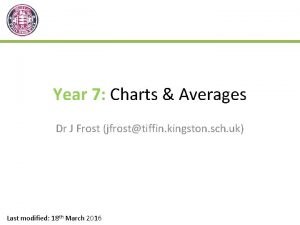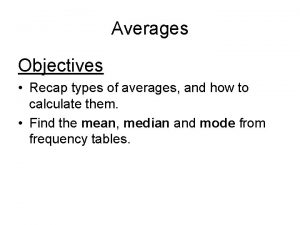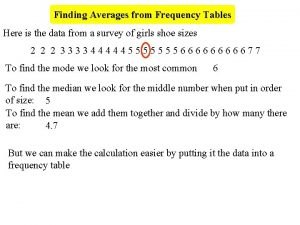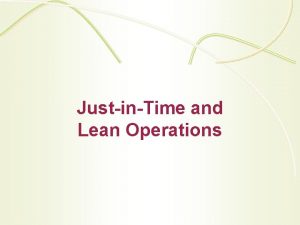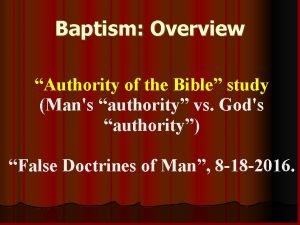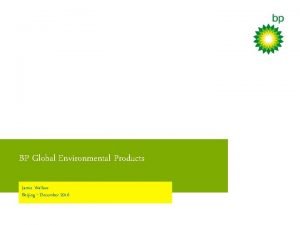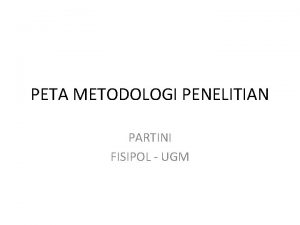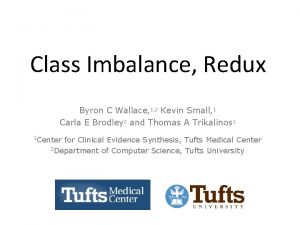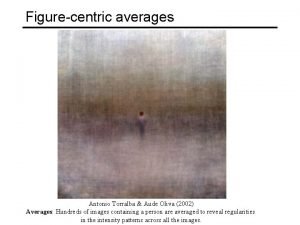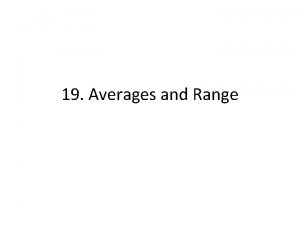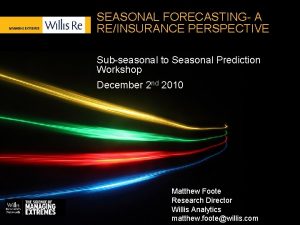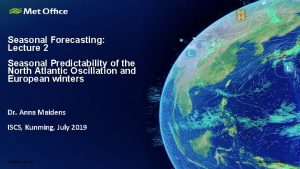Seasonal forecasting Not just seasonal averages Emily Wallace














































- Slides: 46

Seasonal forecasting: Not just seasonal averages! Emily Wallace November 2012 © Crown copyright Met Office

Contents • Traditional seasonal forecasts • Current bespoke products • Tropical storms • Monsoon onset • Hot and cold days • Research into new products • Very wet days in Malaysia © Crown copyright Met Office

Traditional forecasts © Crown copyright Met Office

Glo. Sea 4 ensemble prediction of Nino 3. 4 SST anomaly from March 2010 © Crown copyright Met Office

Precipitation over SE Asia, summer 1998

Reminder: Seasonal forecasts are. . . • Broad-brush • Probabilistic • Large scale • Useful? ?

Impact models: Lake inflow © Crown copyright Met Office

Sector specific applications: Lake Volta, Ghana June forecasts of total July-Oct. inflow Corr. = 0. 69 Preceding rainfall and flow predictors plus seasonal forecast predictors Fcst Obs © Crown copyright Met Office

Reminder: Seasonal forecasts are. . . • Broad-brush • Probabilistic • Large scale • Useful • Wasting information? ?

Tropical storms © Crown copyright Met Office

Current forecast products Public forecast Deterministic forecasts • Provides a best estimate and forecast range (± 1 stdev interval) for: • Numbers of named storms • ACE index • During the following 6 months Tailored products Probabilistic forecasts • Probability distributions • Exceedance of thresholds (to aid assessment of risk) • Help to quantify and communicate the inherent uncertainties in the forecast. © Crown copyright Met Office

Western North Pacific tropical storm tracks in Glo. Sea 5 Storm tracks Model storms have characteristics that are similar to observed storms: • Model storms produced at same latitude • Many storms last longer than 5 days. • Produces straight moving and recurving tracks – important for landfall forecasts Track density • Model peak in TS frequency in the SCS as in observations • Tracks shifted too far north near the dateline. Model Observations June–November 2000– 2009 1 member June–November 1996– 2009 12 members Tropical storm frequency per 5 x 5° box © Crown copyright Met Office

Experimental multi-model seasonal tropical storm forecasts 20 13 240 Skill (1996 -2009) Tropical storms: 0. 47 Typhoons: 0. 62 ACE index: 0. 77 No. forecast ensemble members: 93 © Crown copyright Met Office

Monsoon onset © Crown copyright Met Office

Temporal evolution • Describe “temporal evolution” with local rainfall accumulations between 18 Sep-31 Jan • Express accumulation as percentage of long-term average season total Fraction of season total rainfall example: early onset in individual year • Heavy line: accumulated precip. from climatology Average time of onset • Thin line: accumulated precip. for individual year onset= 20% Time © Crown copyright Met Office

Observed mean evolution: 20 th isochrone • Colours indicate time of local arrival of 20% of average season total rainfall • GPCP average 18 Sep/30 Jan (19962009/10) Observed climatology © Crown copyright Met Office Hindcast climatology

Glo. Sea 4 forecast skill ROC scores 20 th isochrone for 1 August hindcasts Early arrival: © Crown copyright Met Office Late arrival:

Glo. Sea 4 Forecast probabilities for 2011 Short Rains (Sep-Nov) Early onset: Courtesy of Michael Vellinga © Crown copyright Met Office Late onset:

Observations for 2011 Courtesy of Lizzie Good © Crown copyright Met Office

Relocatable Northwest monsoon: Arrival of 30 th isocrone 2011 © Crown copyright Met Office

Hot and cold days © Crown copyright Met Office

What is an extreme day? Extreme day 90 th percentile E. g. 33. 5°C for March 34. 5°C for June © Crown copyright Met Office

What is an extreme day? 2010: 56 extreme days! 2006: No extreme days © Crown copyright Met Office

A global assessment Percentile approach is locally relevant Hamilton et al, 2012, JGR © Crown copyright Met Office

Global assessment: Had. GHCND © Crown copyright Met Office

Results © Crown copyright Met Office

Seasonal temperature: Skill of extremes vs. mean Mean Extremes South east Asia average: 0. 59 © Crown copyright Met Office South east Asia average: 0. 66 Difference -0. 3 0 0. 3 Grey=missing

Is the daily data really providing additional information? © Crown copyright Met Office

Relationship between extremes and mean: Hot days and annual mean temperature © Crown copyright Met Office

Number of days exceeding Relationship in South East Asia seasonally Temperature © Crown copyright Met Office DJF

Extent of the relationship seasonally © Crown copyright Met Office

Change forecast method t s a a c e r dat o F ily da © Crown copyright Met Office

Change forecast method Number of days exceeding Inferring the number of exceedances from the predicted seasonal mean anomaly Temperature © Crown copyright Met Office

Comparing methods Extremes counted from daily data South east Asia average: 0. 49 Difference South east Asia average: 0. 59 © Crown copyright Met Office Extremes inferred from seasonal mean -0. 3 0 0. 3 Grey=missing

Spearman’s Daily data from model gives no skilful information Percentile Extremes counted from daily data © Crown copyright Met Office Extremes inferred from mean

A closer look at the hindcast © Crown copyright Met Office

Product for UK: Cold days © Crown copyright Met Office

Temperature extremes summary • Extremes are predictable on seasonal and decadal timescales. • In general predictability comes from the strong relationship between the seasonal mean and the number of extremes © Crown copyright Met Office

Predictability of daily precipitation extremes…a first look © Crown copyright Met Office

Very wet days (90 th percentile) 10 very wet days © Crown copyright Met Office

Jolly wet days (90 th percentile) 10 very wet days © Crown copyright Met Office

Predictability of very wet days © Crown copyright Met Office

JJ MAM Very wet days: Skill of Total precip : Number of very wet days © Crown copyright Met Office ND ON Similar skill to that of seasonal total precipitation

A closer look at the hindcast Malaysian Peninsular Oct-Nov forecasts of very wet days © Crown copyright Met Office

Conclusions • The Met Office is predicting more user-relevant variables • Tropical storms: Analysis shows that skilful predictions could be made for the western North Pacific basin • Monsoon onset: A useful product in Africa – possible to relocate to South East Asia • Hot and cold days: predictable at seasonal lead time. Predictability linked to seasonal mean temperature predictability • Very wet days: Predictable over South East Asia. • Collaboration needed for best results © Crown copyright Met Office

Questions and answers © Crown copyright Met Office
 Too big too small just right
Too big too small just right In scene 2 what is friar john's excuse
In scene 2 what is friar john's excuse Frequency distribution worksheet
Frequency distribution worksheet Dr frost frequency tables
Dr frost frequency tables How to find mean median and mode in frequency table
How to find mean median and mode in frequency table Types of averages
Types of averages Frequency tables gcse
Frequency tables gcse Comparing averages worksheet
Comparing averages worksheet Prefix averages
Prefix averages Averages from frequency tables
Averages from frequency tables Moving averages gcse
Moving averages gcse Prefix averages
Prefix averages What is the fx column in a frequency table
What is the fx column in a frequency table Averages worksheet
Averages worksheet Sudden and violent but brief; fitful; intermittent
Sudden and violent but brief; fitful; intermittent 580625685 mod 701
580625685 mod 701 Not just anyone
Not just anyone It's not what you say it's how you say it
It's not what you say it's how you say it Not just bingo march
Not just bingo march Just dance cultural appropriation
Just dance cultural appropriation Not much just chillin summary
Not much just chillin summary Jit scheduling tactics
Jit scheduling tactics An update of wallace’s zoogeographic regions of the world
An update of wallace’s zoogeographic regions of the world Edward baker lincoln
Edward baker lincoln Russell wallace day
Russell wallace day Jacobs and wallace attorney
Jacobs and wallace attorney Wallace embryo transfer catheter
Wallace embryo transfer catheter Krisztalloid
Krisztalloid Sebtoilette
Sebtoilette Wallace chen
Wallace chen Modified parkland formula
Modified parkland formula Immersion vs sprinkling baptism
Immersion vs sprinkling baptism Dr steve wallace
Dr steve wallace Jamie wallace bp
Jamie wallace bp Model siklus penelitian wallace
Model siklus penelitian wallace Is survival selfish essay
Is survival selfish essay Platyhelminthes
Platyhelminthes Wallace 9'lar kuralı
Wallace 9'lar kuralı Are any of abraham lincoln's descendants alive
Are any of abraham lincoln's descendants alive Wallace community college scholarships
Wallace community college scholarships Daniel wallace md
Daniel wallace md Lucas held wallace foundation
Lucas held wallace foundation Wallace's line
Wallace's line Alexandra wallace ucla
Alexandra wallace ucla Stein w. wallace
Stein w. wallace Stephen wallace ucla
Stephen wallace ucla Byron c. wallace
Byron c. wallace



